This is my heroine of the week: the redoubtable – and diminuative (she was only 4ft and 10 ins) – Dame Sarah Ann Swift, the founder of the Royal College of Nursing.

Dame Sarah Ann Swift (1854-1937) by Herbert James Draper
Born in 1854, Sarah Swift had had a long and successful career in nursing and proved herself to be an excellent organizer. She had not long retired when war broke out but she immediately offered her services to the government. They accepted and she found herself responsible for the placement of 6000 trained nurses, and VAD nurses, in various war zones. It was 1916, and World War I was about to enter its most bloody stage; the Battle of the Somme, where over one million soldiers were killed.
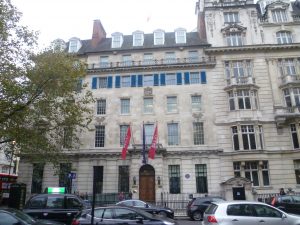
20 Cavendish Square, home of the Royal College of Nursing
Sarah saw that nurses’ training urgently needed to be co-ordinated, with proper registration, and improved status and working conditions; so she fought for a College of Nursing, forging alliances with various influential politicians. Success was not guaranteed. The idea of nurses having a college of their own and being viewed as professionals, instead of contenting themselves with being ‘ministering angels’, was unimaginable for many. Nursing for women tended to be viewed as part of their domestic duties, not as a separate, paid, profession. In 1916 women did not have the vote, so all Sarah could do was lobby; and lobby she did. And she won. (It is cheering to know that she was made a Dame in 1919 in recognition of her War services. And quite right, too.)

The elegant door of the original entrance in Henrietta Place
The new College of Nursing originally had thirty-four members, but by 1918, the membership was over 13,000. Their first home was in Henrietta Place but, in 1925, they moved to 20 Cavendish Square behind Oxford Street, which was bought and then donated to the College by Lady Cowdray, an enthusiastic (and wealthy) supporter.
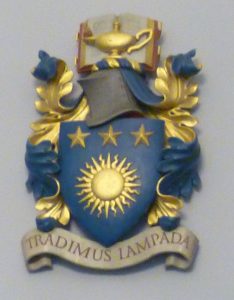
The RCN coat of arms: Tradimus Lampada: We Hand on the Torch
No. 20 had been built as a substantial town house in 1729, possibly by James Gibbs, for the wealthy merchant, Francis Shepherd, M.P. Later, it became the residence of the Prime Minister, H. H. Asquith. In 1930, the building was re-fronted and incorporated by the architect Edwin Cooper into the original College of Nursing in Henrietta Place. It was opened by Queen Mary in 1926, who, apparently, enjoyed taking tea at the College – she particularly liked the cakes!
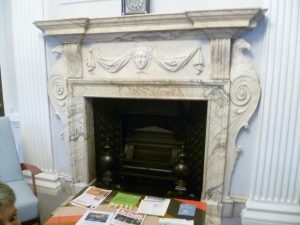
18th century marble mantelpiece
The 18th century core of the building is still there, and there is a splendid marble mantelpiece with the College of Nursing’s blue and gold coat of arms above it bearing the motto Trademus Lampada. The lamp at the top is a reference to Florence Nightingale’s nickname, ‘The Lady with the Lamp’.
There is also a cantilevered staircase with suitably sombre classical wall paintings.
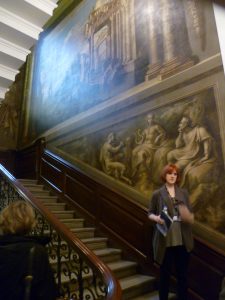
Our guide, Frances Reed, by the 18th century staircase
When you get up to the first floor corridor, however, you can see through the window how much the building has been altered. The original eighteenth century house is still there but now dwarfed by later 20th century alterations to fit it for its new purpose. There is an outside ‘Winter Garden’ where the nurses have barbeques, though not, one hopes, in winter.

View from the 1st floor corridor window: the original red brick building is now surrounded by later buildings. Note the outdoor space for barbeques.
I liked the library with its Nursing History Room, and was intrigued by the post war information books in a glass case, with subjects ranging from Head Louse Infestation, and Woman’s Place (obviously firmly in the home) with a black and white photo of a woman holding her baby aloft, to Manhood: an explanation of sex for young men (what on earth does it say?) to a battered original proof of the Beveridge report.
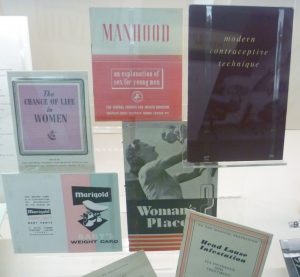
There is also a small shelf of fiction, including a copy of my friend Jean Fullerton’s Fetch Nurse Connie, which has a post war East End community nursing background. Jean is an East Ender herself and was a nurse, and it’s great that her book is seen as worthy of inclusion.
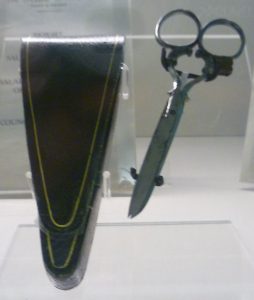
Mary Newbery’s scissors and case, 1920s
There is a small museum, too. I was particularly interested to see Mary Newbery’s scissors with their leather case. Beside it, there is a card which reads: These belonged to Mary Newbery (née Fairchild), a foundling, left in the front garden of a house in Green Lanes, North London. Brought up by the family there, she went on to become trained as a nurse at the Prince of Wales General Hospital, London from 1921-24.
What an opening for a story!
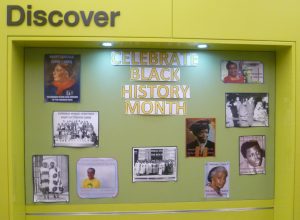
Celebrating Black History Month
This year is the Royal College of Nursing’s centenary (it acquired the ‘Royal’ in 1947) and there are various cases to celebrate how far the R.C.N. has come, including this one celebrating Black History Month.
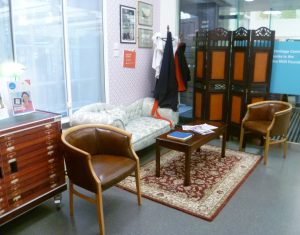
A re-creation of an early 20th century RCN corner
I was very taken with the re-creation of an early 20th century corner from the small exhibition ‘Celebrating 100 years of the RCN’ with its folding Edwardian screen, coat and hat stand with nurses’ cloaks hanging from it, and a chaise longue.
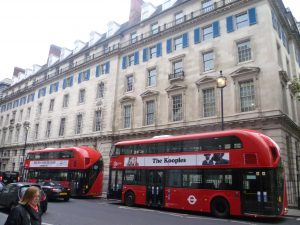
Henrietta Place: the original site of the Royal College of Nursing – and terminus for the 159 bus!
The RCN library and museum is open to the public, Monday-Friday 9am – 7pm, Saturday, 9am – 5pm, via the entrance in Henrietta Place, and there is a nice café. There are also free tours. It’s best to check in advance: www.rcn.org.uk/whatson
It’s a fascinating place and I thoroughly enjoyed my visit.
All photos by Elizabeth Hawksley, apart from the portrait of Sarah Swift by H. J. Draper, courtesy of the DNB.
Elizabeth Hawksley
Please share this page...
How extremely interesting. It sounds as though there are lots of bite-size corners to break the history up and make it more digestible. And how lovely that one of Jean’s books is in the library!
Thank you for your comment, Jan. I enjoy looking round places I wouldn’t normally visit – it’s surprising how many of them are free (and have good cafes, too). I’ve always enjoyed history and, with the RCN, I found the determination of a number of strong-minded women to see that nurses were treated as professionals who deserved fair pay etc, inspiring. And, just sometimes, a story pops up, too, as with the foundling, Mary Newbery.
Lovely post, as ever. Fascinating history, which I had no idea about. And Jean’s book in the fiction is brilliant!
I’m delighted you enjoyed it, Elizabeth. It’s good about Jean’s book, isn’t it? I gave a squeak when I saw it and had to apologise to the guide!
How very interesting. One of my favourite books is One Pair of Feet by Monica Dickens, on her experience of being a rookie nurse during World War II.
Thank you for dropping in, Prem. Yes, I remember the Monica Dickens book – great fun. She was a Charles Dickens’ great-granddaughter and, apparently, a lovely woman with great energy!